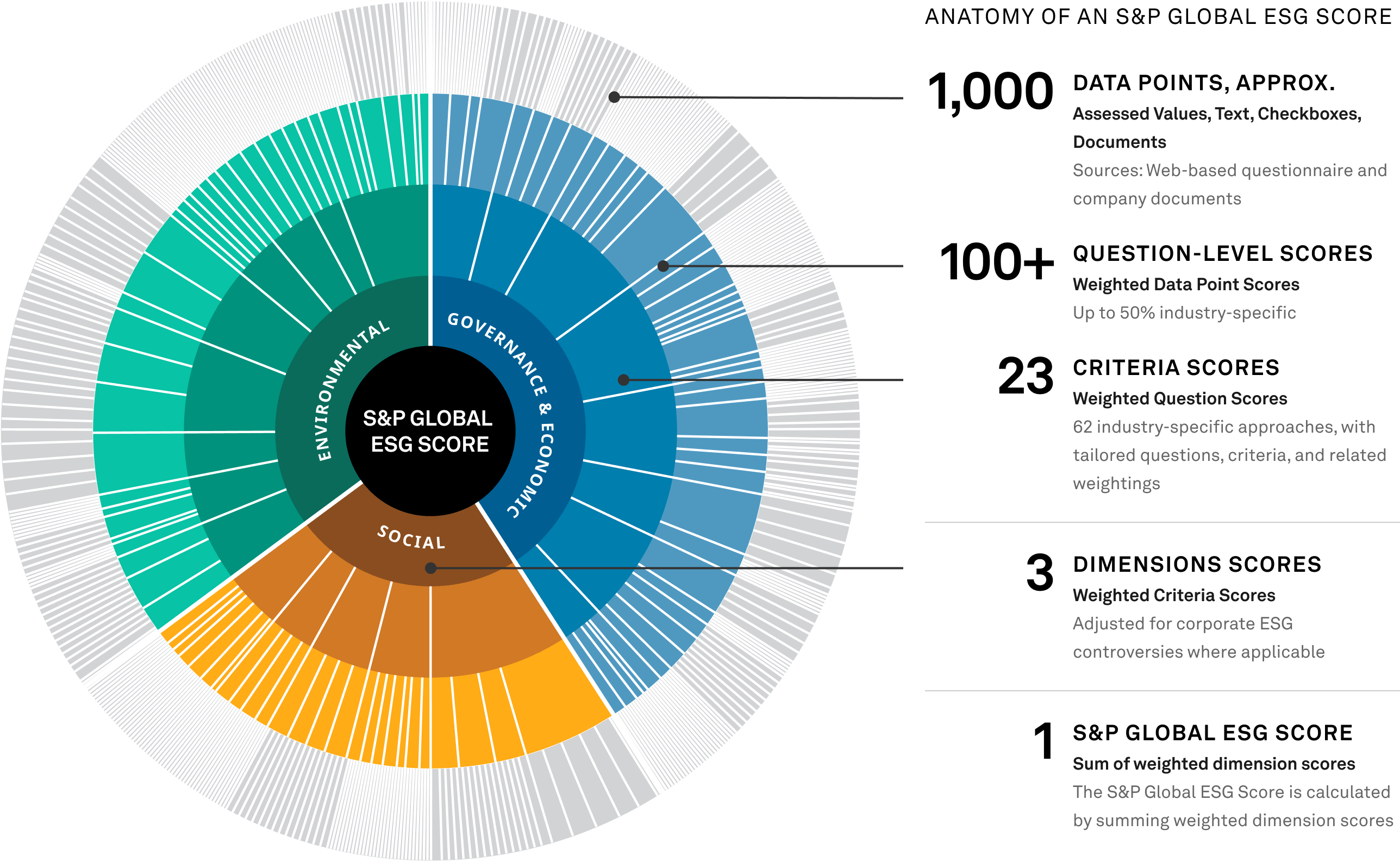- Speak to a Specialist
- Who We Are
- Who We Serve
- Solutions
- Research & Insights
- Events
Sustainability trends such as resource scarcity, climate change, or an aging population continuously reshape a company’s competitive environment. We are convinced that companies that can adapt to such challenges through innovation, quality, and productivity enhance their ability to generate long-term shareholder value. Developed 25 years ago, the CSA aims to identify companies that are better equipped to recognize and respond to emerging sustainability opportunities and challenges presented by global and industry trends.
Based on major global sustainability challenges identified by our ESG analysts at S&P Global, general assessment criteria relating to standard management practices and performance measures such as Corporate Governance, Human Capital Development, and Risk and Crisis Management are defined and applied to each industry in which companies are categorized for the assessment. The general criteria account for approximately 40–50% of the assessment, depending on the industry. The remaining part of the CSA questionnaire is made up of industry-specific risks and opportunities that focus on economic, environmental, and social challenges and trends that are relevant to companies within that industry. Within each criterion, we look for evidence of a company’s awareness of sustainability issues and for indications that it has implemented strategies to address them. We also evaluate the company’s progress in implementing such strategies as well as the quality of its reporting on these issues.
The S&P Global Corporate Sustainability Assessment (CSA) uses a consistent, rule-based methodology to convert an average of 1,000 data points per company to an S&P Global CSA Score (ranging from 0-100). The 62 industry-specific questionnaires each contain approximately 100-130 questions covering, on average, 23 different key themes across the economic, social, and environmental dimensions. The underlying metrics, questions, and criteria that make up the scores are weighted according to their relevance and materiality to a given sub-industry. S&P Global Sustainable1 defines a sustainability issue as material if it presents a significant impact on society or the environment and a significant impact on a company’s value drivers, competitive positioning, and long-term shareholder value creation.
Material sustainability issues can significantly affect an entity’s business operations, cash flows, legal or regulatory liability, and access to capital. They can also significantly improve or undermine an entity’s reputation and relationships with key stakeholders, society, and the environment. As such, S&P Global Sustainable1 considers double materiality as an integral part of the analysis of corporate sustainability performance and the resulting S&P Global ESG Scores.
The S&P Global CSA Score is the S&P Global ESG Score without the inclusion of any modeling approaches. S&P Global ESG and CSA Scores cannot be compared across industries. They measure a company’s sustainability performance relative to industry counterparts. The graphic below visualizes the CSA. The size of the segments reflects the financial materiality assigned at each level as well as the weight applied in the score aggregation process. Learn more at spglobal.com/esg/scores.


The CSA is a holistic assessment, but the structure and score weighting of each criterion depends on its materiality for each industry. To aid companies in preparing for the assessment, we provide the scoring weights associated with these criteria within the Resources section of this website and on the Sustainability Reporting Portal. The weights are also clearly stated on the Company Benchmarking Scorecard available to each company upon receiving its score.
S&P Global uses the Global Industry Classification Standard (GICS®) for determining a company's CSA Industry classification. At the industry group and sector levels, the S&P Global CSA industries match the standard GICS classifications, but some non-standard aggregations are done at the industry level. As of March 2023, there are 62 CSA industries, each with its own version of the CSA questionnaire.
The S&P Global Media and Stakeholder Analysis (MSA) forms an integral part of the CSA. It enables S&P Global to monitor a company's sustainability performance on an ongoing basis by assessing current controversies with potentially negative reputational or financial impacts. The main objective of the MSA process is to gain insight into a company’s ability to mitigate financially material and reputational risks, as well as impacts on stakeholders and the environment, while protecting their shareholder value.
An MSA case typically exposes a failure at a company’s management level and gaps in systems and processes, such as risk management systems and operational controls. Consequently, a company’s S&P Global ESG Score (and accompanying CSA Score) may be adjusted.
The CSA questions are reviewed on an annual basis and adjustments are made to the methodology to enhance reporting, stay relevant with issues already captured, and address emerging, forward-looking sustainability issues that are expected to have an impact on companies in the coming years. This approach allows the CSA questionnaire to address under-reported topics of interest to investors and other stakeholders while also familiarizing companies with new sustainability topics that may be part of upcoming regulatory changes or future reporting guidelines or requirements. A detailed review of the previous year’s results is also performed at the end of each assessment cycle to identify areas for improvement, apply scoring updates, provide methodology clarifications, or to re-consider questions that can be removed from the questionnaire.
See related documentation here.
We continuously seek to improve the CSA methodology to ensure that it remains market relevant. We aim to capture emerging trends and the material topics in each industry.
As part of the methodology development process for the CSA, any current draft proposals for comment are published in this section.
Draft proposals for which the comment period has ended are available for reference here.